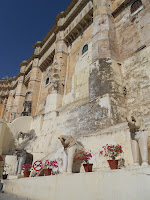I honestly have no idea how to write this. Everyone wants to know how I feel about
finally coming home. I usually talk
about the cliché happy-sad conundrum, but honestly I am astonished at how
little emotional response I have right now.
It feels surreal. What it boils
down to is that I really cannot grasp the fact that I won’t be in this country
for much longer. Here I am, less than 24
hours from takeoff, and it still hasn’t hit me.
It’s the little things that remind me: charging my American phone
because I’m leaving my Indian one here; seeing my closet empty and my suitcases
full; my outfit picked out, folded and ready along with my blazer, waiting for
the morning. My year is over. My exchange, my time here, finished. The way exchange works is that you get
excited about the program and jump right in, thinking about the year that faces
you. This year, though, is a strange,
arbitrary time frame in which your life changes, your morals are questioned,
and your views on everything are turned upside down. Looking ahead, ‘a year’ seems like such a
short time to accomplish so much, yet such a long time to be away from
everything familiar. Heading into the
program, ‘the end’ seems like a far-off imaginary time that you will never
reach. For better or for worse (believe
me, there are times of both), you are stuck on a treadmill of time and seem to
make no dent in the year while you hit benchmark after cultural benchmark, and
understand more and more of the people and place that surround you. Then just when you start to think this year
will stretch on forever, you fall off the treadmill and start running full
speed toward the door. It comes much
faster than expected and soon you have made it to the door, facing the finality
of your worldly, life-changing experience.
‘The end’ sounds so grand, so important – I couldn’t help but picture it
as a bigger ordeal. However, my end
seems like a whisper next to the roaring year I have had. I convinced myself that this moment would
have some profound significance for me but in reality it was the rest of my
year that holds meaning; leaving is simply the definitive end. Despite my cacophony of emotions here I am,
one foot out the door.
This is the blog post I have mulled over for an entire year, wondering
what I could possibly say to satisfactorily sum up a year of experiences and
learning. As far as my expectations for
this year, I have fallen short on some while taking on many other challenges I
could not have imagined. I think this is
part of the program. If I did everything
according to what I planned, what kind of cultural exchange would it be? In the end, my year was turning strangers
from across the globe into some of my closest friends and together learning to
thrive in one of the most different cultures in the world. I’ve conquered chili peppers, Indian roads, and
eating with my hands, and there’s not a challenge facing me that shakes the
confidence I have developed this year. I
have met a greater variety of people and broadened my mind more than I could
ever have guessed. This year made me
appreciate alternative ways of living in addition to a more profound awareness
of my life in the United States.
As I leave here, I am extremely excited to return home to see my
family and friends again, and experience all the things I have missed this
year. However, a piece of me fears that
I have exaggerated how great home is.
Are Minnesotans as friendly as I make them out to be? Are the streets as clean and the roads as
organized? Can a steak burrito from
Chipotle possibly live up to the ridiculous standard to which my mind holds it? I am not sure how accurate my image of home
is, and I am almost positive it will feel strange after a year of adjusting to
this lifestyle. That just means that I
have done something right this year.
Leaving behind all that I have built in India is by far the saddest part
of this moment. I am not simply leaving
a city, I am leaving a home, a family, a life, and I will miss all of it more
than I could ever have anticipated coming into this year. Finding differences and similarities across
the globe has been one of the most rewarding experiences of my life and I am
certainly not going to end here. Like
many of my fellow exchange students, this year has developed in me a strong
desire to explore the vast variety of the world and an eagerness to understand
other cultures. This will last me the
rest of my life, and I hope it takes me to many unique and unexpected
places.
As the monsoon rains begin to fall in Pune and I complete a full
cycle of seasons, I look forward to making the most of summer in
Minnesota. I have purposefully packed my
schedule for the next three months, and cannot wait to get to work crossing
things off, hanging out with my brothers and friends, and playing an obscene
amount of ultimate frisbee. I will be
happily too busy to write again, and this seems like the natural end to my
blog. It has been a great tool for me to
process my thoughts, and I hope it has served to spread a little cultural
understanding as well. Thank you to
Rotary for creating this opportunity for so many people around the globe. India will forever be my home and I will
always appreciate this amazing adventure.

































